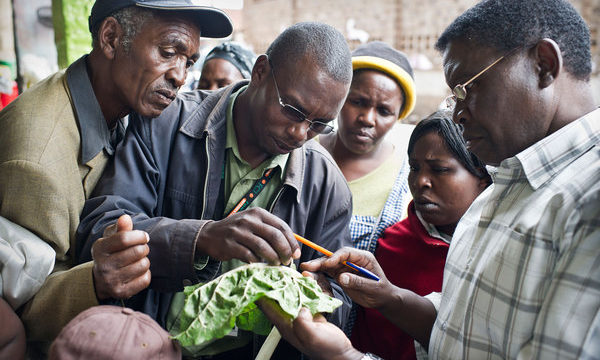Symptoms of citrus greening on citrus leaf © CABI
Mabel Smith is an Oxfordshire school student, studying both the arts and the sciences. She is interning at CABI for Plantwise and the marketing department.
The disease, citrus greening, which is also known as huanglongbing and caused by the fastidious bacteria Candidatus Liberibacter, continues to cause problems for Floridian growers this week. The psyllids that spread this pathogen are now running rampage throughout more than half of Florida’s citrus producing counties, causing an expected 20% decline in harvest. Over the last 20 years around 60 million citrus trees have been abandoned across half a million acres of land due to this rapidly spreading and, so far, incurable disease. Citrus greening has already caused irreversible damage in Asia and South America and many growers in Florida are giving up on the citrus market altogether to turn to more reliable alternatives like peach growing. Despite this, many growers are still optimistic and millions of dollars are currently being invested in further agricultural research into a cure.
Some growers, including Richard Skinner, owner of Hawkins Corner Nursery, are reluctant to replace infected trees as they can no longer see the benefits of growing the citrus they were forced to pull down – particularly when new trees require almost a decade of growth before they are able to produce fruit. It seems that many who are abandoning the citrus market are beginning to try their hand at peach growing. Many growers now have several acres of peach trees replacing their infected citrus yet Mike Sparks, executive director of the Lakeland-based Florida Citrus Mutual says the peach crop is “never going to replace the citrus crop here.” Citrus is Florida’s iconic crop and the rain, heat and soil provide an unbeatable citrus growing climate.
While the search for the cure still remains, some researchers are beginning to develop citrus therapies in the hope of extending the lives of infected trees. One method, used currently, involves wrapping infected trees with material that absorbs the sun’s heat in order to raise the temperature of the trees to 128 degrees. This technique appears to extend the life of the dying tree in order to allow fruit to ripen fully which therefore reduces fruit loss.
Although there is currently no definitive cure or chemical control, biological control is sometimes possible through the use of a psyllid parasite. However, in most cases this control is not possible as the psyllid parasites have their own parasites, which could reduce the efficiency of using these species for biocontrol. Also, biocontrol would keep the psyllid population at a low level when really it needs to be completely eradicated. At current, the most effective form of control is through strict quarantine measures and, in some countries like South Africa, the removal of infected branches or whole trees from the main crop in order to reduce the spread of the pathogen. The U.S. Department of Agriculture’s Animal and Plant Health Inspection Service has also imposed stricter quarantines at state and country borders in an attempt to prevent further spreading of the disease. Researchers hope that their efforts to find a cure to citrus greening will come before too many groves, that form part of the $9 billion industry, are forced to be pulled from citrus production.
Find out more about control of citrus greening on the Plantwise knowledge bank.
Related News & Blogs
Five yield-threatening pests and diseases of rice
Pests and diseases of rice are a significant constraint in rice production, accounting for up to 30% of yield losses. Rice is cultivated in over 100 countries and is a staple food source for over half the world’s population. Therefore, the sustainable…
28 November 2023

